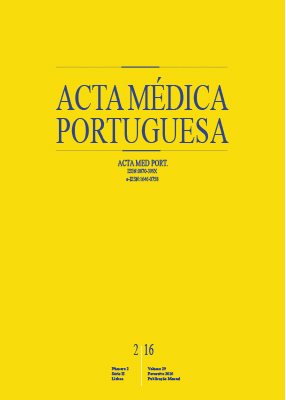Impact of Compliance with a Sepsis Resuscitation Bundle in a Portuguese Emergency Department.
DOI:
https://doi.org/10.20344/amp.6998Keywords:
Emergency Service, Hospital, Guideline Adherence, Portugal, Sepsis, Shock, Septic.Abstract
Introduction: Severe sepsis and septic shock are common conditions with high levels of morbi-mortality surpassing those of coronary heart disease or stroke. The reality of hospital treated sepsis is largely unknown outside of the intensive care unit. We therefore aimed to evaluate the level of compliance with the Surviving Sepsis Campaign 6-hour bundle in a Portuguese emergency department and to relate it to the patient clinical outcomes.
Material and Methods: We conducted a retrospective, observational cohort study with 178 severe sepsis/septic shock patients admitted to the intensive and intermediate care unit between January 1st 2012 and December 31st 2012.
Results: In the study, period septic shock was diagnosed in 100 patients (56.2%) and severe sepsis in 78 patients (43.8%). Compliance with the sepsis bundle was: (1) 62.9% for lactate measurement; (2) 62.9% for blood cultures before antibiotics; (3) 41.6% for antibiotics in the first 3 hours; (4) 76.4% for fluid administration; (5) 25% for vasopressor administration; (6) 37% for central venous pressure measurement and (7) 39% for central venous oxygen saturation measurement. Full compliance was observed in 22% of the patients. The individual bundle measure - Blood cultures before antibiotics - was significantly associated with a decreased risk of both intensive care unit mortality and 28-day mortality. There was also a trend for an inverse correlation between increased compliance with the full bundle and the intensive care unit and 28-days hospital mortality.
Discussion: There was a low compliance with the Surviving Sepsis Campaign 6-hour bundle, a result that replicates the findings in similar international studies. The explanation is complex but it may include the lack of institutional quality monitoring in the emergency department.
Conclusions: The compliance with a sepsis resuscitation bundle starting in the emergency department was positively associated with the outcomes of the septic patients. Nonetheless the bundle was unreliably performed.
Downloads
Downloads
Published
How to Cite
Issue
Section
License
All the articles published in the AMP are open access and comply with the requirements of funding agencies or academic institutions. The AMP is governed by the terms of the Creative Commons ‘Attribution – Non-Commercial Use - (CC-BY-NC)’ license, regarding the use by third parties.
It is the author’s responsibility to obtain approval for the reproduction of figures, tables, etc. from other publications.
Upon acceptance of an article for publication, the authors will be asked to complete the ICMJE “Copyright Liability and Copyright Sharing Statement “(http://www.actamedicaportuguesa.com/info/AMP-NormasPublicacao.pdf) and the “Declaration of Potential Conflicts of Interest” (http:// www.icmje.org/conflicts-of-interest). An e-mail will be sent to the corresponding author to acknowledge receipt of the manuscript.
After publication, the authors are authorised to make their articles available in repositories of their institutions of origin, as long as they always mention where they were published and according to the Creative Commons license.









